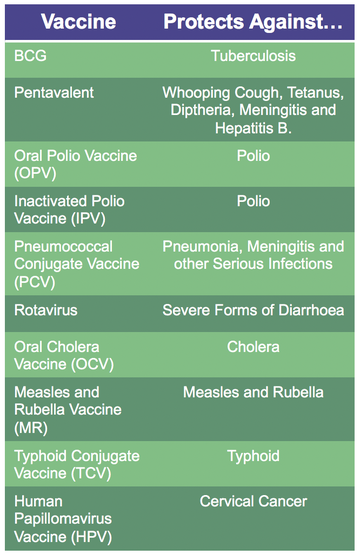Vaccines Protect

BCG
Protects against Tuberculosis (TB).
Given right after birth in upper-left arm.
A blister will form where the injection was given and it normally heals with a small scar.
Babies are at high risk for TB. That is why they must be vaccinated quickly, on the day they are born or as soon as possible.
Pentavalent
Protects against whooping cough, tetanus, diptheria, meningitis and hepatitis B.
Requires three injections in the thigh.
Ideally administered at 6, 10 and 14 weeks from birth.
(Penta) is a combination of five vaccines in one dose. An infant needs 3 doses of Penta vaccine to be fully protected.
Oral Polio Vaccine (OPV)
Protects against polio.
Drops given in the child’s mouth.
Given three times, ideally at 6, 10 and 14 weeks from birth.
Inactivated Polio Vaccine (IPV)
Protects against polio.
Injection on thigh for young children or upper arm for older children.
Given at 14 weeks from birth.
IPV and OPV both protect against polio but in different ways and it is important that children have both vaccines.
It is important that all children receive at least one dose of IPV as it provides extra protection against polio on top of the protection from OPV.
Pneumococcal Conjugate Vaccine (PCV)
Protects against pneumonia, meningitis and other serious infections.
Also helps prevent ear infections.
3 injections in the thigh at 6, 10, 14 weeks after birth.
Rotavirus Vaccine
Protects against severe forms of diarrhea.
Drops given in the child’s mouth.
Oral Cholera Vaccine
Protects against cholera.
Drops given in the child’s mouth.
Measles and Rubella Vaccine (MR)
Protects against measles and rubella
Injection given on thigh or upper arm.
Injection given at 9 and 15 months.



Comments 0
Please log in or create your account
Related Articles
Vaccine FAQ
© The Internet of Good Things